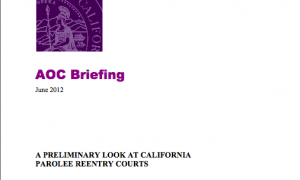 The Best Of: The following article. published on April 15, 2012, describes the critical part the court can play in the development of balanced sentencing plans under California’a AB109 Realignment Reform.
The Best Of: The following article. published on April 15, 2012, describes the critical part the court can play in the development of balanced sentencing plans under California’a AB109 Realignment Reform.
Reading dozens of articles over the past six months on how California’s AB109 Realignment is being implemented is not for the faint of heart (see Facebook collumn on right for exemplars). An ACLU report complains that counties that historically sent the highest percentage of offenders to prison are being rewarded with extra resources to jail those returning, and additional funds to build or expand existing jails( click here for Mercury News Article on ACLU Report). Prosecutors, Sheriffs, and law enforcement in general decry the very existence of AB109; that non-violent offenders can be returned to the community without a terrible price being paid by law-abiding citizens (click for Law Enforcement concerns in Butte County). Probation offices and non-profit organizations (including community based agencies and religious institutions) generally favor giving individual offenders opportunities to engage in community based alternatives to incarceration( click here for article on Monterey County’s community-based initiatives). And so in community after community, county after county, they fight it out, generally law enforcement against probation and non-profit community organizations, with the court often often an uninvolved, yet interested observer.
The courts have an unprecedented opportunity to impact their community’s quality of life. We have operated in a somewhat dysfunctional system, that weighed heavily toward sending offenders to prison. We now have a chance to help create a more balanced and reasoned approach to sentencing and incarceration. One way to accomplish this will be to develop more effective “Special Sentencing Courts” (see “Systemic Approaches to Sentencing”), that make better sentencing, probation, and custody decisions, based on validated risk/needs assessment tools (and other evidence based sentencing practices). More importantly, the courts needs to get involved in their county’s realignment plan, by using their prestige and influence, to help establish a balanced community-wide approach to realignment. Problem-Solving/Collaborative Courts have shown communities that the courts can make a difference, by providing the vision and leadership for important criminal justice reforms. And so it can be with Sentencing Courts and Realignment.
Success will depend on the degree of cooperation and accomodation individual communities are capable of. Once again the court can weigh in on the side of a rational, reasoned approach. Success in the end may start and end with a community’s willingness to provide the returning offender with job, education, and housing opportunites, as well as rehabilitation programs that have scientifically proven themselves. Jailers and probation staff will need to rely on evidence-based risk/needs assessments to determine who really needs to return to jail, and who can be supervised and rehabilitated in the community. And the courts need to provide a sentencing system worthy of the community’s balanced realignment plan. It’s being attempted in a number of counties, and one can only wish them well. And hope that other communities will learn from their example (click here for article on San Diego Realignment Plan).


